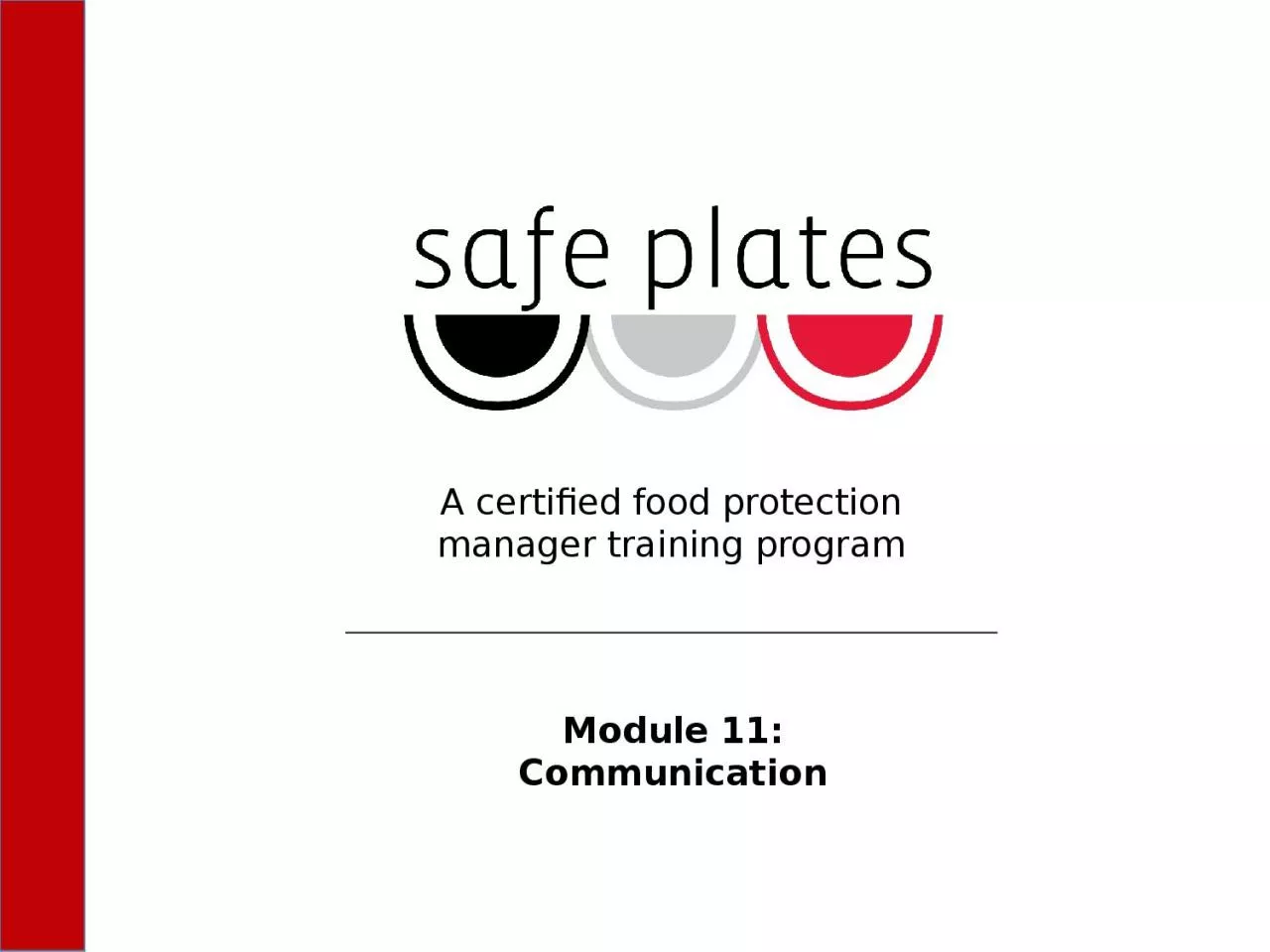

DISCUSSION Learning Objectives Identify sources of physical and chemical contamination Describe threats of deliberate contamination Discuss other types of toxins and the risks associated with these ID: 915460
Download Presentation The PPT/PDF document "Module 11: Communication" is the property of its rightful owner. Permission is granted to download and print the materials on this web site for personal, non-commercial use only, and to display it on your personal computer provided you do not modify the materials and that you retain all copyright notices contained in the materials. By downloading content from our website, you accept the terms of this agreement.
Slide1
Module 11: Communication
Slide2Slide3DISCUSSION
Slide4Learning Objectives
Identify sources of physical and chemical contaminationDescribe threats of deliberate contaminationDiscuss other types of toxins and the risks associated with theseRespond to customer inquiries and complaints
Slide5Chemical Contamination
Cleaning products, sanitizers, polishes, lubricants and pesticidesProper storage:Away from food, utensils, and equipmentSeparate storage area in original containers Label properly if transferred to another container
Careful use during operating hours
Consider using conveniently located staging areas
Safety Data Sheets
Slide6Physical Contamination
Foreign objects accidentally introduced into the foodGlass, metal from surfaces and utensils, packaging material, rubber gloves, bandages, finger nails…Naturally occurring objectsBone, shells, dirt and rocks
Can cause physical injury or cross contamination
Slide7Slide8Other Types of Contamination
Naturally Occurring Toxins – Some food can contain toxins that can make people sickEx. fish, shellfish, and mushrooms.
Slide9Naturally Occurring Toxins
Fish Toxins - Produced by fish:Puffer fish, moray eels, freshwater minnowsProduced by microbes in fish
Histamine/
Scromboid
toxin – from temperature abuse
Ciguatoxin
– from algae, accumulates in warm water fish
Shellfish (filter feeders) toxins (ASP, DSP, NSP, and PSP)
Slide10Slide11Naturally Occurring Toxins
Amnesic Shellfish Poisoning (ASP) – confusion, memory loss, disorientationDiarrheic Shellfish Poisoning (DSP) – chills, nausea, vomiting, cramps, diarrhea
Neurotoxic Shellfish Poisoning (NSP)
– tingling and numbness lips, tongue, throat, reversal hot/cold sensations
Paralytic Shellfish Poisoning (PSP)
–tingling and numbness
Slide12Mycotoxin
- toxin produced by molds on grains, nuts, and dried fruitsToxin is not destroyed by heat.
Slide13Deliberate Contamination
Food Defense is the prevention of intention contamination of foodMaybe you recall:
Slide14Slide15Addressing Food Defense
Be Observant!
Slide16How Can We Control These Risks?
Hazard Analysis Critical Control Points (HACCP) is a proactive food safety management system for the analysis and control of biological, chemical, and physical hazards from raw material production, procurement and handling, to manufacturing, distribution, and consumption of the finished product.
Not mandatory, but laws are the minimum…
Slide17Hazard Analysis Critical Control Points
Many food service operations choose to use this system to minimize risk of contamination.
Steps
Ex. Hamburger
1
Identify hazards
E. coli
2
Determine critical control points
Cooking Temp.
3
Set critical limits
155
o
F for 15 sec.
4
Establish monitoring procedures
Temp
e
very batch
5
Set corrective actions
Heat longer
6
Record keeping and documentation
Prove it!
7
Establish verification procedures
Check its done
Slide18Customer Complaints
Complaints can be complicatedWhat really happened?Who is right? Is anyone right?What is the appropriate response?Every situation will be different
Be prepared to address issues
Have staff prepared to address issues
Slide19Managers and Customers
Are you prepared to handle:Questions about qualityQuestions about food sources, storage, preparation, ingredientsQuality complaints
Illness/injury complaints
Slide20Servers and Customers
Your staff may be the first contacted by customersKeep your staffed informed with information commonly asked for by customers Be receptive to questions and complaints. Avoid confrontation or arguments.
“I don’t know but I’ll find out” is a great answer… make sure they know where to go for the answer.
Slide21Preparing for Crisis
Identify Key ContactsAssess Potential Problems
Identify Audiences
Communication Material
Slide22Identify Key Contacts
WhoWithin your businessOwners, managers, employeesCounty Public HealthInspector and county leadershipEmergency services
Suppliers – make sure its good
What
Contact information
Establish relationships
Understand expectations in crisis situations
Slide23Assess Potential Problems
What potential events do you want to have a plan in place for?A few examples:Sick worker (Hepatitis A)Customer illness or injury Served product subject to recall
Customer complaint
Slide24Identify Audiences
Who should you contact in case of a problem?Within your businessPublic health and health care officialsEmergency services
Media
Slide25Communication Material
Share information so people can make appropriate decisionsEstablish trust and build credibilityHow you communicate depends on the audience. Use simple languageExplain the issue and risks
Take on responsibility where appropriate
Describe any action you deem in necessary for that audience
Slide26What’s Your View?
What do you try to keep in mind when receiving a customers complaint?
Slide27How Could It Have Been Prevented
What was the hazard at the DQ shake?How could it have been prevented?
Slide28Activity
Slide29Activity
One of your food service staff just received a complaint about a hair in a customer’s salad.Server: “It’s the same guy who asked if the lettuce was GAP certified and if the dressing had peanut oil. And he has a BEARD! I totally know its his own hair. I even told him so, and now he wants to talk to you.”
Slide30Activity
In groups of 3-4 discuss:How do you deal with this customer?Now, discuss:What would you say to the server?How would your response change if it was a call about foodborne illness?
Slide31Quiz
How many steps are involved in making a HACCP plan?56
7
8
Slide32Quiz
How many steps are involved in making a HACCP plan?56
7
8
Slide33Quiz
Food Defense is:The prevention of intentional contamination of foodThe prevention of accidental cross contamination
Controlling the temperature of food to prevent growth of bacteria
None of these
Slide34Quiz
Food Defense is:The prevention of intentional contamination of foodThe prevention of accidental cross contamination
Controlling the temperature of food to prevent growth of bacteria
None of these
Slide35Case Study
Riley Chase ordered a vanilla shake.
Tasted like chemicals
How It Happened
What Went Wrong
A container with chemical cleaner was left in a sink. Another employee put vanilla in the container with out cleaning it.
Slide36Case Study
Use properly labeled containers
Employee communication
Prevention
Communicating with customers, authorities, media
Afterword
Slide37Review
Chemical, physical, biological contaminationIntentional contaminationCustomer complaintsCommunication